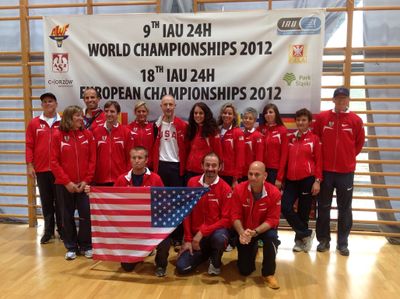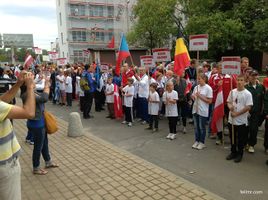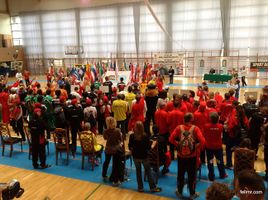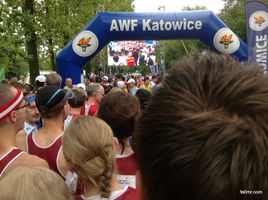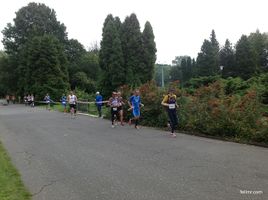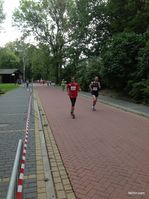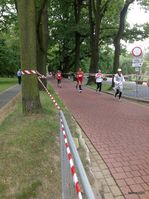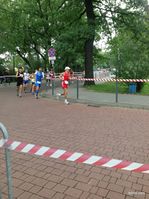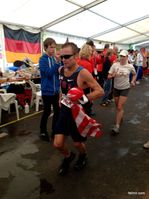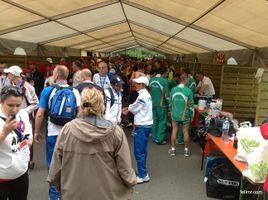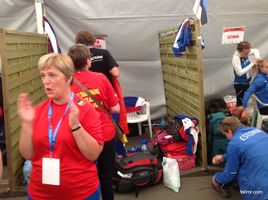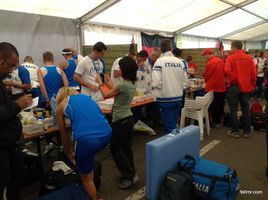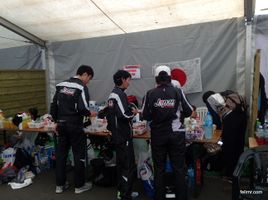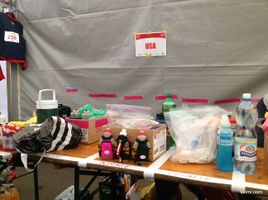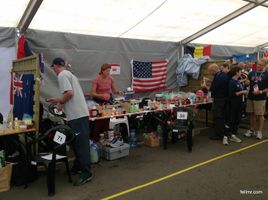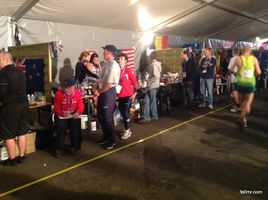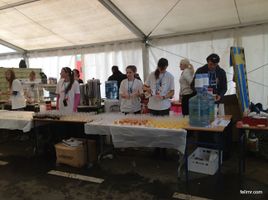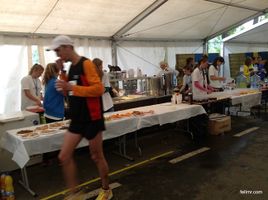Difference between revisions of "2012 Poland 24 Hour World Championships"
User:Fellrnr (User talk:Fellrnr | contribs) |
User:Fellrnr (User talk:Fellrnr | contribs) |
||
| Line 13: | Line 13: | ||
* You have far less freedom of choice in the world championships. You have to stay in the accommodation and wear the team uniform, both on and off the track. The USA team was sponsored by Nike, who provided the uniform and by the USA Track & Field which helped offset some of the cost of travel. | * You have far less freedom of choice in the world championships. You have to stay in the accommodation and wear the team uniform, both on and off the track. The USA team was sponsored by Nike, who provided the uniform and by the USA Track & Field which helped offset some of the cost of travel. | ||
These different aspects of the event produce a remarkably different experience. There is a strong sense of being a team and of national identity. | These different aspects of the event produce a remarkably different experience. There is a strong sense of being a team and of national identity. | ||
| + | <gallery widths=300px heights=200px caption="The Opening Ceremony"> | ||
| + | File:PolandTrip 042.JPG|The teams gather outside. Notice the country names are in English and Polish. | ||
| + | File:PolandTrip 055.JPG|Each team enters in turn; you can see the USA team entering. | ||
| + | File:PolandTrip 058.JPG|The flag ceremony, with each of the flags for the 34 countries represented. | ||
| + | </gallery> | ||
=Before the race= | =Before the race= | ||
I travelled with my wife Lynn from Charlotte to Katowice via Munich, leaving Tuesday afternoon and arriving Wednesday afternoon, which was about 23 hours door to door. We stayed in student dorm rooms at the local university, which were Spartan but comfortable. All food was provided, and we had a couple of race briefings on the Thursday and Friday. Friday was also the opening ceremony, with all teams in their country uniforms and a gymnastics display. We got to walk around Katowice a little, and I reveled in being in a foreign culture. I slept well Wednesday and Thursday, but Jetlag caught up on Friday night, and I was wide awake until 3am. Only getting 3 hours sleep before a 24 hour race is worrying, but I was not sleepy until later Sunday night after the race. | I travelled with my wife Lynn from Charlotte to Katowice via Munich, leaving Tuesday afternoon and arriving Wednesday afternoon, which was about 23 hours door to door. We stayed in student dorm rooms at the local university, which were Spartan but comfortable. All food was provided, and we had a couple of race briefings on the Thursday and Friday. Friday was also the opening ceremony, with all teams in their country uniforms and a gymnastics display. We got to walk around Katowice a little, and I reveled in being in a foreign culture. I slept well Wednesday and Thursday, but Jetlag caught up on Friday night, and I was wide awake until 3am. Only getting 3 hours sleep before a 24 hour race is worrying, but I was not sleepy until later Sunday night after the race. | ||
=The Course= | =The Course= | ||
The course was just under a mile and was rectangular in shape. Though it was nearly flat, the aid station was on the long downhill section, so you didn't get the full advantage of the slope. It was also the point where you'd naturally take a walking break to eat or drink, so you have a choice between walking on the downhill or carrying your provisions half way around the loop. I had two problems with the course – the brick surface and the sharp turns. Half of the course was a brick surface with the remainder being asphalt. Most of the brick surface was quite good, but one section was made of old bricks that were breaking up. I did not get any blisters, but the bricks seemed to cause problems deep in the foot that were remarkably painful. The international organizers (IAU) did not know of the bad surface until the day before the race, and there was talk of changing the course, but that never happened. The sharp turns did not bother me at first, but after a few hours I started to have problems with my left hip rotator. The course was well lit, so there was no need to carry a light, which was nice. Also, there was a big display by the start line, and the idea was to show each runner's lap time and lap number. However, the display was so close to the timing mat that the display was too late to be of any use. The park itself was beautiful and we saw a few weddings photos being taken around us. | The course was just under a mile and was rectangular in shape. Though it was nearly flat, the aid station was on the long downhill section, so you didn't get the full advantage of the slope. It was also the point where you'd naturally take a walking break to eat or drink, so you have a choice between walking on the downhill or carrying your provisions half way around the loop. I had two problems with the course – the brick surface and the sharp turns. Half of the course was a brick surface with the remainder being asphalt. Most of the brick surface was quite good, but one section was made of old bricks that were breaking up. I did not get any blisters, but the bricks seemed to cause problems deep in the foot that were remarkably painful. The international organizers (IAU) did not know of the bad surface until the day before the race, and there was talk of changing the course, but that never happened. The sharp turns did not bother me at first, but after a few hours I started to have problems with my left hip rotator. The course was well lit, so there was no need to carry a light, which was nice. Also, there was a big display by the start line, and the idea was to show each runner's lap time and lap number. However, the display was so close to the timing mat that the display was too late to be of any use. The park itself was beautiful and we saw a few weddings photos being taken around us. | ||
| + | <gallery widths=300px heights=200px caption="The Course"> | ||
| + | File:PolandTrip 081.JPG|Just before the start of the race. You can see the big screen TV that was a good idea, but failed miserably. | ||
| + | File:PolandTrip 084.JPG|Lining up to start. | ||
| + | File:PolandTrip 092.JPG|Me on the asphalt part of the course. | ||
| + | File:PolandTrip 097.JPG|Serge on the right, running well over the smoother brick section. | ||
| + | File:PolandTrip 099.JPG|Another part of the smoother brick section, slightly uphill. Not much uphill until you've run 100 miles. | ||
| + | File:PolandTrip 100.JPG|One of the corners. Three were similar to this and the fourth was quite a bit sharper. | ||
| + | File:PolandTrip 125.JPG|Mike Morton at the end of the race, carrying our flag and still moving fast. Notice Mike is focused on running hard to the end, not showing off. | ||
| + | </gallery> | ||
=The aid station= | =The aid station= | ||
| − | The aid for this race was quite different to anything else I've experienced. There was a large tent that held the aid station with an area for each team. This tent was a few hundred feet long, with aid tables were on both sides of the track. We were very tight on space, with each runner having about 12 inches x 18 inches of table space (30cm x 45 cm). No aid could be given to a runner outside of the aid tent, and the crew were limited to within one meter (3 feet) of the front of the table and were forbidden to accompany a runner. This meant we only had one person in front of the aid table, which caused a number of problems. One person could not remember everything that each runner needed, or sometimes even understand what they wanted. Getting the wrong thing in a 24 hour race can be disastrous; one runner got tonic water rather than carbonated water. The two are similar, but tonic water contains quinine, which can cause diarrhea. The | + | The aid for this race was quite different to anything else I've experienced. There was a large tent that held the aid station with an area for each team. This tent was a few hundred feet long, with aid tables were on both sides of the track. We were very tight on space, with each runner having about 12 inches x 18 inches of table space (30cm x 45 cm). No aid could be given to a runner outside of the aid tent, and the crew were limited to within one meter (3 feet) of the front of the table and were forbidden to accompany a runner. This meant we only had one person in front of the aid table, which caused a number of problems. One person could not remember everything that each runner needed, or sometimes even understand what they wanted. Getting the wrong thing in a 24 hour race can be disastrous; one runner got tonic water rather than carbonated water. The two are similar, but tonic water contains quinine, which can cause diarrhea. Another runner could not get their usual drinks and had to eat cake instead, which caused some problems. One runner was given [[Caffeine]], which they'd never had before; luckily there were no serious adverse effects. |
| + | <gallery widths=300px heights=200px caption="The Aid Station"> | ||
| + | File:PolandTrip 068.JPG|The aid station tent, with tables either side of the course. Later a yellow line will be laid down to show the crews how far back they have to stay. | ||
| + | File:PolandTrip 071.JPG|Teams with fewer runners have less space. Here the Belgium team is objecting to just how little space they have. | ||
| + | File:PolandTrip 072.JPG|The Italian team has three massage therapists; you can see one of their tables in the foreground. | ||
| + | File:PolandTrip 074.JPG|The Japanese team is well organized. They had a whiteboard up showing the positions of each of their team and the leader. This was great, as I had little or no idea how anyone was doing other than this board, which showed Mike M’s lead. | ||
| + | File:PolandTrip 077.JPG|You can see how little room each runner has for their stuff. | ||
| + | File:PolandTrip 090.JPG|Here is the aid station in use. You can see the yellow line that the crews had to stay behind, which was a great idea. It got ignored in the last 30 min of the race, but otherwise worked well. | ||
| + | File:PolandTrip 102.JPG|The USA area during the race. Sometimes the crew in front of the table made it hard for a runner to get what they wanted. | ||
| + | File:PolandTrip 107.JPG|The USA area at night. | ||
| + | File:PolandTrip 104.JPG|The shared race aid station showing the drinks. The water looks bottled, but is filled from a hose. | ||
| + | File:PolandTrip 103.JPG|The food on the shared aid station. | ||
| + | </gallery> | ||
=My Race= | =My Race= | ||
My race started well, and I tried to go out slowly, which is tough when the leaders are passing you at a breathtaking pace. I was a little too aggressive, and I was on a 160+ mile pace for the first 8 hours. Things were going well at this point except for my left hip flexor and my feet. I stopped and massaged the hip flexor and it was fine after that. However, the rough brick section of the course was pounding my feet and the pain was quite remarkable. Some [[NSAIDs and Running|Ibuprofen]] reduced both the pain and some of the swelling, but it was still a concern. Somewhere near the 13 hour mark, my right hip rotator become painful and wanted to go into spasm. I stopped at the aid station to use [[The Stick]] on it, but within a few moments of stopping I became overwhelmed with nausea and light headedness and had to sit down. After 30 minutes I get moving again, which was a tough as I got quite chilled and stiff. I walked a couple of laps, and then when I tried a little broth, the nausea hit me again. I was stopped for 90 minutes that time and I was only able to get out of the chair after the team doctor gave me some prescription anti-nausea medication. The medication removed most of the nausea, but things were still not quite right. I was able to stand, and after a while start walking again. At that point the competitive race was over for me, and so I tried some intermittent running, then resorted to simply walking. I was kept company by Deb for the last 5 hours, and we walked together, cheering on the USA team as they continued to lap us. | My race started well, and I tried to go out slowly, which is tough when the leaders are passing you at a breathtaking pace. I was a little too aggressive, and I was on a 160+ mile pace for the first 8 hours. Things were going well at this point except for my left hip flexor and my feet. I stopped and massaged the hip flexor and it was fine after that. However, the rough brick section of the course was pounding my feet and the pain was quite remarkable. Some [[NSAIDs and Running|Ibuprofen]] reduced both the pain and some of the swelling, but it was still a concern. Somewhere near the 13 hour mark, my right hip rotator become painful and wanted to go into spasm. I stopped at the aid station to use [[The Stick]] on it, but within a few moments of stopping I became overwhelmed with nausea and light headedness and had to sit down. After 30 minutes I get moving again, which was a tough as I got quite chilled and stiff. I walked a couple of laps, and then when I tried a little broth, the nausea hit me again. I was stopped for 90 minutes that time and I was only able to get out of the chair after the team doctor gave me some prescription anti-nausea medication. The medication removed most of the nausea, but things were still not quite right. I was able to stand, and after a while start walking again. At that point the competitive race was over for me, and so I tried some intermittent running, then resorted to simply walking. I was kept company by Deb for the last 5 hours, and we walked together, cheering on the USA team as they continued to lap us. | ||
| Line 39: | Line 65: | ||
As always, there are things that did not work. | As always, there are things that did not work. | ||
* Nike Free did not work on the broken brick cobbles, transmitting the unevenness far too well. There was a strange effect even on the good brick surface where the sole would seem to occasionally stick to part of the road and tweak my foot. It was like having someone running too close behind and tapping your foot as you toe off. I will try the [http://www.zappos.com/hoka Hokas], which two of our team had and seemed to work remarkably well. | * Nike Free did not work on the broken brick cobbles, transmitting the unevenness far too well. There was a strange effect even on the good brick surface where the sole would seem to occasionally stick to part of the road and tweak my foot. It was like having someone running too close behind and tapping your foot as you toe off. I will try the [http://www.zappos.com/hoka Hokas], which two of our team had and seemed to work remarkably well. | ||
| − | * Not sure what caused the nausea, as it was strong and accompanied by light headedness. I don't think I was dehydrated, and while my stomach was not happy, it was not bad enough to explain the severity of my symptoms. It could have been low blood pressure, but I would not expect it to last so long, or be so severe if I was not dehydrated. | + | * Not sure what caused the nausea, as it was strong and accompanied by light headedness. I don't think I was dehydrated, and while my stomach was not happy, it was not bad enough to explain the severity of my symptoms. It could have been low blood pressure, but I would not expect it to last so long, or be so severe if I was not dehydrated. The drinking water was coming from a hose, so that could also be a cause of some of the digestive problems. |
=Things to change= | =Things to change= | ||
There are a number of things I will change next time around. | There are a number of things I will change next time around. | ||
Revision as of 11:05, 21 September 2012
I was part of the 2012 team representing the USA at the 24 hour world championship in Katowice, Poland. My race went badly, with severe nausea and light headedness preventing me from moving for a couple of hours half way through the race. The team as a whole won several medals:
- Men's individual Gold, Mike Morton, 172 miles (a new American Record)
- Women's individual Silver, Connie Gardner, 149 miles (a new American Record)
- Bronze for both the men's and women's teams.
Although I'm disappointed with my failure, the overall experience was wonderful.
Contents
1 What's different about the World Championships?
There are some obvious differences with the World Championships, and some rather more subtle ones.
- You are competing against the best ultrarunners in the world. Each country sets its own qualifying standards, so some smaller countries have lower standards and fewer runners, but everyone there is a top runner. Consider that 20 people ran over 150 miles, and I once won a 24 hour race with 117 miles, which would only get 132nd place in this race.
- The race has far more stringent rules, including dope tests for the winners. Pacing is not allowed, including a male and female competitor running together, as the man will be considered as pacing the woman.
- In addition to the individual competition, there is a team competition as well. The three men and women on each team with the highest mileage have their total distance added together.
- This race was also the European championships, and there are separate medals for each. Each country can enter up to 6 men and 6 women into the world championships, but up to 9 in the European race, so some athletes were doing both events, and others just one.
- You have far less freedom of choice in the world championships. You have to stay in the accommodation and wear the team uniform, both on and off the track. The USA team was sponsored by Nike, who provided the uniform and by the USA Track & Field which helped offset some of the cost of travel.
These different aspects of the event produce a remarkably different experience. There is a strong sense of being a team and of national identity.
- The Opening Ceremony
2 Before the race
I travelled with my wife Lynn from Charlotte to Katowice via Munich, leaving Tuesday afternoon and arriving Wednesday afternoon, which was about 23 hours door to door. We stayed in student dorm rooms at the local university, which were Spartan but comfortable. All food was provided, and we had a couple of race briefings on the Thursday and Friday. Friday was also the opening ceremony, with all teams in their country uniforms and a gymnastics display. We got to walk around Katowice a little, and I reveled in being in a foreign culture. I slept well Wednesday and Thursday, but Jetlag caught up on Friday night, and I was wide awake until 3am. Only getting 3 hours sleep before a 24 hour race is worrying, but I was not sleepy until later Sunday night after the race.
3 The Course
The course was just under a mile and was rectangular in shape. Though it was nearly flat, the aid station was on the long downhill section, so you didn't get the full advantage of the slope. It was also the point where you'd naturally take a walking break to eat or drink, so you have a choice between walking on the downhill or carrying your provisions half way around the loop. I had two problems with the course – the brick surface and the sharp turns. Half of the course was a brick surface with the remainder being asphalt. Most of the brick surface was quite good, but one section was made of old bricks that were breaking up. I did not get any blisters, but the bricks seemed to cause problems deep in the foot that were remarkably painful. The international organizers (IAU) did not know of the bad surface until the day before the race, and there was talk of changing the course, but that never happened. The sharp turns did not bother me at first, but after a few hours I started to have problems with my left hip rotator. The course was well lit, so there was no need to carry a light, which was nice. Also, there was a big display by the start line, and the idea was to show each runner's lap time and lap number. However, the display was so close to the timing mat that the display was too late to be of any use. The park itself was beautiful and we saw a few weddings photos being taken around us.
- The Course
4 The aid station
The aid for this race was quite different to anything else I've experienced. There was a large tent that held the aid station with an area for each team. This tent was a few hundred feet long, with aid tables were on both sides of the track. We were very tight on space, with each runner having about 12 inches x 18 inches of table space (30cm x 45 cm). No aid could be given to a runner outside of the aid tent, and the crew were limited to within one meter (3 feet) of the front of the table and were forbidden to accompany a runner. This meant we only had one person in front of the aid table, which caused a number of problems. One person could not remember everything that each runner needed, or sometimes even understand what they wanted. Getting the wrong thing in a 24 hour race can be disastrous; one runner got tonic water rather than carbonated water. The two are similar, but tonic water contains quinine, which can cause diarrhea. Another runner could not get their usual drinks and had to eat cake instead, which caused some problems. One runner was given Caffeine, which they'd never had before; luckily there were no serious adverse effects.
- The Aid Station
5 My Race
My race started well, and I tried to go out slowly, which is tough when the leaders are passing you at a breathtaking pace. I was a little too aggressive, and I was on a 160+ mile pace for the first 8 hours. Things were going well at this point except for my left hip flexor and my feet. I stopped and massaged the hip flexor and it was fine after that. However, the rough brick section of the course was pounding my feet and the pain was quite remarkable. Some Ibuprofen reduced both the pain and some of the swelling, but it was still a concern. Somewhere near the 13 hour mark, my right hip rotator become painful and wanted to go into spasm. I stopped at the aid station to use The Stick on it, but within a few moments of stopping I became overwhelmed with nausea and light headedness and had to sit down. After 30 minutes I get moving again, which was a tough as I got quite chilled and stiff. I walked a couple of laps, and then when I tried a little broth, the nausea hit me again. I was stopped for 90 minutes that time and I was only able to get out of the chair after the team doctor gave me some prescription anti-nausea medication. The medication removed most of the nausea, but things were still not quite right. I was able to stand, and after a while start walking again. At that point the competitive race was over for me, and so I tried some intermittent running, then resorted to simply walking. I was kept company by Deb for the last 5 hours, and we walked together, cheering on the USA team as they continued to lap us.
6 After the race
After the race, we had to walk across the park to the awards ceremony, which was a long way in the hot sun, taking the weary runners about 20 minutes or more. We had runners who could not walk, and had to find a motorized cart to take them. When we arrived, we found we were part of a large festival, which was nice, but we were outside in the full sun with no food or drink. After about half an hour or so, we were told that plans had changed and the awards would be back at the athletes village. So, we walked back across the park to take a bus back to our accommodations. Again we had to find a cart, which caused some problems when one of our runners became separated from their supporting family. Back at the athletes village things changed again and we were told we would have a meal before the awards ceremony. We sat down to eat about 4 hours after the finish of the race.
7 Summary
Though I'm obviously disappointed with my performance, the overall experience has been wonderful. Though there were some logistical problems that go along with this type of competition, the fact that the other runners and their crews were such nice people more than made up for it.
8 What Worked
There were a number of things that worked well:
- The Go Juice kept me well fueled. I was particularly glad of an extra 32oz (2 litres) after the race.
- I trained with a lot more Downhill Running and Downhill Intervals which may seem strange for a flat race, but it gave my quads far greater fatigue resilience. (I did find the inner part of the quad (Vastus Medialis) got sore, which I've not had before.)
- My Garmin 310XT allowed me to keep track of how far I'd gone. Several other runners seemed unaware of where they were, and I like to know if I'm on pace or not. (I had to turn the GPS functionality off and rely on theFootPod to get the battery to last.)
- Because the laps are not exactly a mile, I wrote down my target paces on the back of my hand. You might think you could remember a couple of numbers, but it gets tricky to think after a few hours. With hindsight, I'll write down some key lap conversions (e.g. 50 miles = 52 laps) on my other hand next time.
- Wearing an Under Armor Heat Gear Top prevented chaffing, which would have been a big problem given I had to wear a singlet as part of the uniform.
- I put some patterned duct tape on all my gear so the crew knew what things went with each runner. I'll do that in the future for all my gear. (I use this Penguin Patterned Duck Tape.)
- The Three Phase Taper seemed to work well, and I used Medium Intensity High Volume Intervals for the second week of the taper, doing 40x400, rest, 32x400, rest, 24x400, 12x400, 12x400, 12x400, 3 easy, rest, rest, rest, race.
- Listening to music helped me stay focused on my running and not worrying about being passed by others. My little San Disk Clip Zip lasted for 14 hours and they're so cheap I had two with my. I also had a USB battery pack that I didn't use, but another runner on our team used it to charge their iPod.
- Mid-race Massage works amazingly well. I fixed my hip flexor and if I could have got to my hip rotator properly, I think I could have at least reduced the problem there.
9 Did not work
As always, there are things that did not work.
- Nike Free did not work on the broken brick cobbles, transmitting the unevenness far too well. There was a strange effect even on the good brick surface where the sole would seem to occasionally stick to part of the road and tweak my foot. It was like having someone running too close behind and tapping your foot as you toe off. I will try the Hokas, which two of our team had and seemed to work remarkably well.
- Not sure what caused the nausea, as it was strong and accompanied by light headedness. I don't think I was dehydrated, and while my stomach was not happy, it was not bad enough to explain the severity of my symptoms. It could have been low blood pressure, but I would not expect it to last so long, or be so severe if I was not dehydrated. The drinking water was coming from a hose, so that could also be a cause of some of the digestive problems.
10 Things to change
There are a number of things I will change next time around.
- As well as my Go Juice I will also make up some DIY Electrolyte Drink, as hydrating on the go juice alone can provide more calories than my body wants.
- A saw another runner do some simple stretching on each lap, and I think that may help.
- Crunching down potato chips (crisps) and putting them in a drinking cup seemed to work well for some runners. It's far easier to eat them that way.
- I tried super glue for the first time on a cut on my finger before the race, and I'm impressed with how well it worked, so I will experiment further.
- I need to practice slower running more, especially getting the forward lean right.
